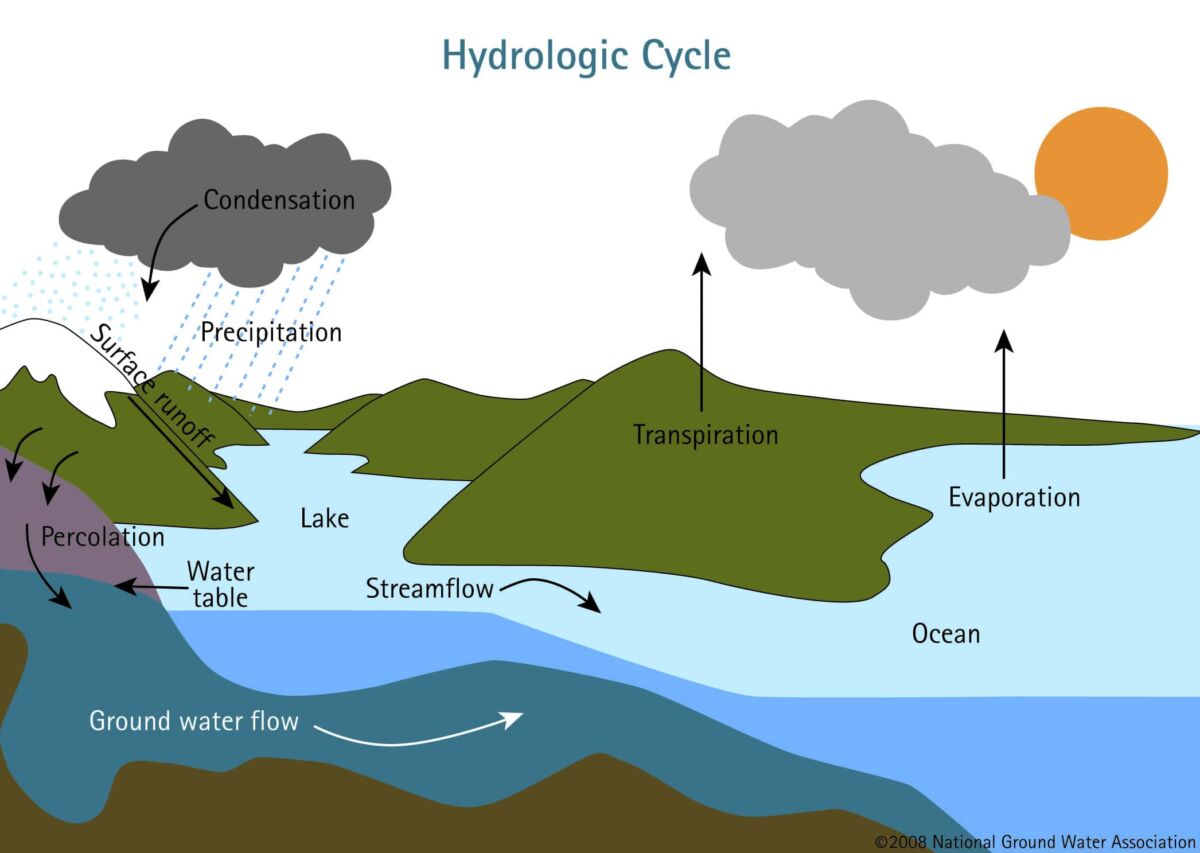Water Cycle Study Guide
Check out awesome, educational VR rooms on Inspirit’s mobile app (available for iOS and Android devices)🤩
Introduction:
Water on earth is in a constant state of motion in what is called the hydrologic cycle or the water cycle. This cycle occurs because the interaction of energy with water frequently changes states and is carried about by the weather or other physical processes.
What is the water cycle?
The water cycle process details the movement of water on earth. Water in the ocean evaporates to form clouds through condensation. The clouds are carried over to the land by seasonal winds. Precipitation in the form of rain from the clouds distributes water across the land, some of which runs off into rivers, and some becomes groundwater. The river flows back to the ocean and starts the water cycle again.
The water cycle is part of the biogeochemical cycles that take place on a daily basis to maintain a balanced ecosystem. Unlike energy gained and lost by systems, matter in the form of elements and compounds is recycled within the system. Chemical compounds cycle through both the biotic and abiotic parts of ecosystems. Water, for example, goes through both plants and animals in its journey in the water cycle.
Water can stay in different stages of the water cycle for different lengths of time. Components that retain water for a short time are called exchange pools. The atmosphere is an example of an exchange pool that holds water only for a few days. On the other hand, lakes and oceans are called reservoirs as they hold water for a longer period.
A simple water cycle can also occur in the form of groundwater being pumped out by humans for various purposes. This water evaporates again to form clouds and rain down elsewhere to form groundwater, lakes, or rivers again. The figure below explains the process of the water cycle with an illustration:
What steps make up the process of the water cycle?
The hydrological cycle involves a series of complex physical and chemical processes that leads to the change of state of water and its transportation.
1. Evaporation
Evaporation is the change of state of water from liquid to water vapor or moisture. Heat is required for the water to evaporate, and almost all of it comes from the sun. During the day, the sun’s heat causes water from lakes and oceans and even the ground to evaporate. This water forms clouds or stays in the air as moisture.
2. Transpiration
Transpiration is how plants contribute to the hydrological cycle by releasing moisture into the air. The leaves of plants have small porous openings called stomata, which help in gas exchange. It also releases water vapor which leads to an increase in humidity.
3. Sublimation
Water under the seal-level pressure changes states by going through solid, liquid, and gas in that respective order. However, when the pressure is lower in high altitudes and mountainous regions, ice directly changes state to water vapor without becoming a liquid first. This process is called sublimation. Sublimation is the process through which high-altitude clouds form and disappear.
4. Condensation
Condensation is the change of state from water vapor to liquid water. Rising air currents lift moisture higher into the atmosphere. The colder temperature causes the moisture to condense on microscopic dust particles in the air to form clouds.
5. Precipitation
Clouds are made out of microscopic droplets of water which can join together to form bigger droplets because of the action of air currents. When the droplets are too big to stay suspended in the air, it falls as precipitation or rain.
Precipitation at high altitudes causes water to freeze and deposit as ice or snow. Snow is also formed in regions where the temperature is too low for water to remain liquid. The frozen water deposits as snow on mounts and forms glaciers.
6. Runoff
Runoff refers to the water that flows like rivers and streams to join larger lakes or oceans. Runoff is one of the important ways freshwater makes it back to the ocean.
7. Infiltration
Infiltration is how the water makes it into the ground through pores in the soil. It seeps underground to form groundwater and fill up the water table. This water is absorbed by plants and then transpired back into the atmosphere.
Conclusion:
- The water cycle is part of biogeochemical cycles, which are closed processes where chemical compounds and elements are recycled in a system.
- The water cycle is the movement of water through ecosystems and the environment. It occurs in evaporation, condensation, precipitation, and collection stages.
FAQs:
1. What is the water cycle 7 Steps?
To explain the water cycle in 7 steps, it’s essential to know:
- Evaporation
- Transpiration
- Sublimation
- Condensation
- Precipitation
- Runoff
- Infiltration
3. What is the process of the water cycle?
The water cycle process involves the change of state of water and the movement of water through the ecosystems.
4. How do you explain the water cycle to a child?
The water cycle can be explained to a child using a simple example. Water from the ocean evaporates to become clouds. Clouds move over land and produce rain. The rainwater becomes rivers and streams and flows back to the ocean.
5. What is evaporation in the water cycle?
Evaporation is how liquid water becomes water vapor when heated.
We hope you enjoyed studying this lesson and learned something cool about Water Cycle! Join our Discord community to get any questions you may have answered and to engage with other students just like you! Don’t forget to download our App to experience our fun, VR classrooms – we promise, it makes studying much more fun! 😎
Sources:
- The Water Cycle. https://flexbooks.ck12.org/cbook/ck-12-middle-school-earth-science-flexbook-2.0/section/8.3/primary/lesson/processes-of-the-water-cycle-ms-es/. Accessed 11 Dec, 2021.
- 18.8 The Water Cycle – Advanced. https://www.ck12.org/book/ck-12-biology-advanced-concepts/section/18.8/. Accessed 11 Dec, 2021.
- Biogeochemical cycle. https://www.britannica.com/science/biogeochemical-cycle. Accessed 11 Dec, 2021.


